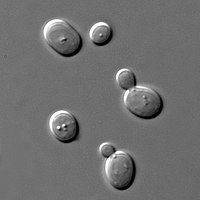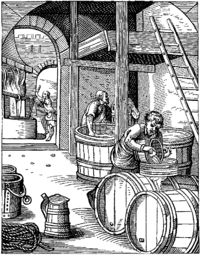
Evaluation of genetic diversity and development of core collections of industrial brewing yeast using ISSR markers.
Sign Up to like & getrecommendations! Published in 2020 at "Archives of microbiology"
DOI: 10.1007/s00203-020-02091-8
Abstract: Germplasm of industrial brewing yeast of the worldwide have a richer diversity, and various successes in improving the performance of brewing yeasts. However, they are limited in that they have relatively low odds of combining… read more here.
Keywords: diversity; genetic diversity; core collections; industrial brewing ... See more keywords

Brewing with malted barley or raw barley: what makes the difference in the processes?
Sign Up to like & getrecommendations! Published in 2018 at "Applied Microbiology and Biotechnology"
DOI: 10.1007/s00253-018-9537-9
Abstract: Malted barley is the main source for fermentable sugars used by yeasts in the traditional brewing of beers but its use has been increasingly substituted by unmalted barley and other raw grain adjuncts in recent… read more here.
Keywords: malted barley; barley; raw grains; barley raw ... See more keywords

A re-evaluation of diastatic Saccharomyces cerevisiae strains and their role in brewing
Sign Up to like & getrecommendations! Published in 2020 at "Applied Microbiology and Biotechnology"
DOI: 10.1007/s00253-020-10531-0
Abstract: Diastatic strains of Saccharomyces cerevisiae possess the unique ability to hydrolyze and ferment long-chain oligosaccharides like dextrin and starch. They have long been regarded as important spoilage microbes in beer, but recent studies have inspired… read more here.
Keywords: saccharomyces cerevisiae; cerevisiae strains; evaluation; role ... See more keywords

Elucidation of key odorants in Beninese Roselle (Hibiscus sabdariffa L.) infusions prepared by hot and cold brewing.
Sign Up to like & getrecommendations! Published in 2020 at "Food research international"
DOI: 10.1016/j.foodres.2020.109133
Abstract: Roselle (Hibiscus sabdariffa L.) is an edible flower belonging to the large family of Malvaceae. Aroma is one of the crucial parameters to determine the final tea overall quality and the consumer's preference and it… read more here.
Keywords: hot cold; cold brewing; key odorants; roselle hibiscus ... See more keywords

Mycotoxins in malting and brewing by-products used for animal feed
Sign Up to like & getrecommendations! Published in 2017 at "Journal of Biotechnology"
DOI: 10.1016/j.jbiotec.2017.06.1033
Abstract: Malting and brewing by-products (germ/rootlets, spent grains and spent yeast) represent a valuable and nutritious source of food for the livestock. The incidence of mycotoxins in animal feed is not an unusual phenomenon, and for… read more here.
Keywords: germ rootlets; brewing products; animal feed; brewing ... See more keywords

[Non-conventional yeasts as tools for innovation and differentiation in brewing].
Sign Up to like & getrecommendations! Published in 2021 at "Revista Argentina de microbiologia"
DOI: 10.1016/j.ram.2021.01.003
Abstract: Yeasts play a crucial role in brewing. During fermentation, besides ethanol and carbon dioxide, yeasts produce a considerable number of organic compounds, which are essential for beer flavor. In particular, Saccharomyces cerevisiae and Saccharomyces pastorianus… read more here.
Keywords: non conventional; tools innovation; yeasts tools; conventional yeasts ... See more keywords

Removal of trihalomethanes and haloacetamides from drinking water during tea brewing: Removal mechanism and kinetic analysis.
Sign Up to like & getrecommendations! Published in 2020 at "Water research"
DOI: 10.1016/j.watres.2020.116148
Abstract: Disinfection by-products (DBPs) are associated with various adverse health effects. Diversiform advanced treatment processes have been applied for the control of DBPs, but DBPs can still be frequently detected in tap water. Tea-leaves can be… read more here.
Keywords: tea brewing; water; removal; dbps ... See more keywords

Nanostructured Hybrid BioBots for Beer Brewing
Sign Up to like & getrecommendations! Published in 2023 at "ACS Nano"
DOI: 10.1021/acsnano.2c12677
Abstract: The brewing industry will amass a revenue above 500 billion euros in 2022, and the market is expected to grow annually. This industrial process is based on a slow sugar fermentation by yeast (commonly Saccharomyces… read more here.
Keywords: brewing; yeast; nanostructured hybrid; fermentation ... See more keywords

Influence of coffee brewing methods on the chromatographic and spectroscopic profiles, antioxidant and sensory properties
Sign Up to like & getrecommendations! Published in 2021 at "Scientific Reports"
DOI: 10.1038/s41598-021-01001-2
Abstract: Cold brewing coffee has gained increasing popularity as a novel brewing method. A completely different flavour profile during cold brewing extraction (smooth and mild) is a result of the low-energy process, prolonged water-grind contact times… read more here.
Keywords: extraction; influence coffee; coffee; coffee drinks ... See more keywords

Overview of craft brewing specificities and potentially associated microbiota
Sign Up to like & getrecommendations! Published in 2019 at "Critical Reviews in Food Science and Nutrition"
DOI: 10.1080/10408398.2017.1378616
Abstract: ABSTRACT The brewing process differs slightly in craft breweries as compared to industrial breweries, as there are fewer control points. This affects the microbiota of the final product. Beer contains several antimicrobial properties that protect… read more here.
Keywords: overview craft; craft brewing; brewing; beer ... See more keywords

Effect of Brewing Temperature on the Total Antioxidant Capacity of Green Tea
Sign Up to like & getrecommendations! Published in 2021 at "Journal of Food and Nutrition Research"
DOI: 10.12691/jfnr-9-6-3
Abstract: The relationships between the total available antioxidant capacity of green tea and the brewing temperature and preparation time were studied, with the Trolox equivalent antioxidant capacity (TEAC) assay used to determine the antioxidant levels. The… read more here.
Keywords: antioxidant capacity; temperature; green tea; tea ... See more keywords